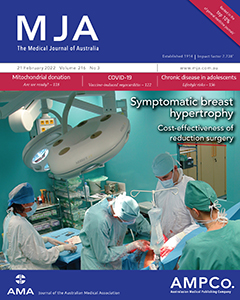
Flinders Caring Futures Institute researchers have spearheaded what they believe is the first economic evaluation of breast reduction surgery for Australian women with breast hypertrophy, focused purely on cost-effectiveness of the procedure.
Professor Julie Ratcliffe and Dr Christine Mpundu‐Kaambwa, forming part of a wider Flinders University team, considered all the surgery and health-related costs to reach an outcome. They found the procedure was cost-effective and led to positive outcomes for women with breast hypertrophy.
The cost-utility analysis was the final component of a thesis by PhD candidate Tamara Crittenden, an example of a highly productive partnership between Flinders’ College of Nursing and Health Sciences and College of Medicine and Public Health.
Professor Ratcliffe says breast hypertrophy can cause debilitating physical and psychosocial impairment in some women.
“A lot of women will experience backache, from posture problems, as well as emotional impacts stemming from embarrassment, as it’s a condition they are born with and can’t do much about unless they have access to treatment,” she explains.
“It impacts on their social connectiveness, social relationships and personal relationships. It can have a huge impact.”

Breast reduction surgery is considered the only option for women who want a resolution, which can cost upwards of $10,000. Access to the expensive treatment through public health varies depending on where people live.
“Some Australian states define the procedure as a cosmetic procedure, so they don’t really recognise it as a procedure that is clinically important, and other jurisdictions define it as an aesthetic-type procedure,” Professor Ratcliffe says.
In South Australia, it’s considered a restricted procedure. Patients can only be referred to a breast clinic if they meet strict criteria. Even if they do, Professor Ratcliffe says women with breast hypertrophy often experience long waits for surgery.
“Because we don’t have a consistent strategy across Australia, it’s a bit of a postcode lottery as to whether women will be able to access this surgery in the public health system.”
The Flinders study focused on the health-related quality of life benefits of this type of surgery for women with this condition.
“It was a prospective cohort study – women who were diagnosed with the condition and referred to Flinders Medical Centre were followed up for a long period of time,” Professor Ratcliffe says, adding that women who received the surgery, those who were seeking surgery but hadn’t yet received it and those who didn’t qualify and therefore didn’t receive the surgery were included.
To undertake the cost-utility analysis, the team measured the costs associated with the surgery and the health-related quality of life benefits of receiving the surgery. The quality-adjusted life year is the main measure of outcome that health economists use in conducting cost-effectiveness analysis of any sort of procedure or treatment or intervention in the health system.

“It’s a generic measure of outcome and it really focuses on the survival or life years gained in terms of interventions, but also the quality of those life years,” Dr Mpundu-Kaambwa explains.
When the research team considered all the surgery and health-related costs, it found the procedure was cost-effective and led to positive outcomes for women with breast hypertrophy.
“In this case, we found the quality of life of the women who received the breast reduction surgery was higher than their peers who did not have the surgery,” Dr Mpundu-Kaambwa says. “The women who didn’t have the surgery had lower scores on the quality-of-life instrument.”
Members of the research team were pleased to have their findings published in The Medical Journal of Australia recently.

“This is obviously hitting a nerve with clinicians in Australia, who are aware of the inconsistency of approach to breast reduction surgery for women in this position,” Professor Ratcliffe argues.
“The study provides evidence that it is cost-effective, and we should therefore be moving to a situation in Australia where we offer uniform access to surgery for women who have symptomatic breast hypertrophy.”

